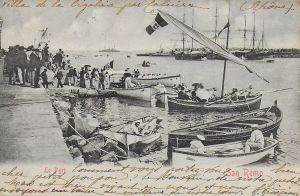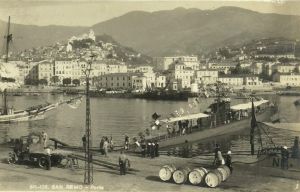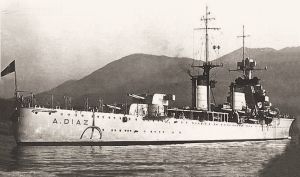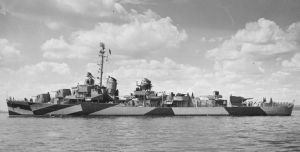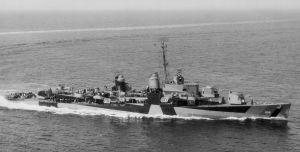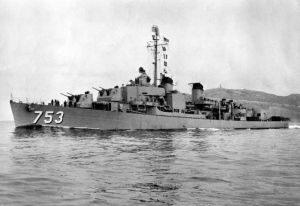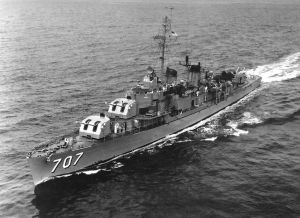IN THE PORT AND ROADSTEAD OF SANREMO
(EDITED BY DINO TAULAIGO)
Years 1887 - 1888
On the first of December 1887 three German battleships arrived in Sanremo to pay homage to the KronPrinz (Crown Prince) of Germany Federico Guglielmo, a guest at Villa Zirio.
On 25th January 1888, the Italian Royal Navy's Agostino Barbarigo was also present in the roadstead to pay homage to the future Emperor of Germany, as reported in the newspaper of the time "L'Armonia", representing the King. 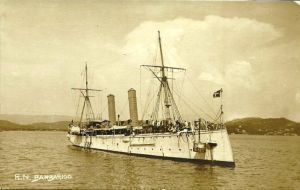 I
I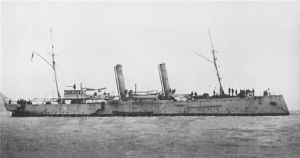 n fact, on that date the 30th Anniversary of the Kronprinz's marriage to Princess Victoria was celebrated and the ship was not only illuminated "in a fascinating way" with the electric light on board, but also projected it onto the villas and hills of Sanremo, producing "a magical effect".
n fact, on that date the 30th Anniversary of the Kronprinz's marriage to Princess Victoria was celebrated and the ship was not only illuminated "in a fascinating way" with the electric light on board, but also projected it onto the villas and hills of Sanremo, producing "a magical effect".
But probably the stay of the Avviso Barbarigo in the roadstead in Sanremo lasted longer, because on 18 January 1888 he was visited by Prince Henry of Prussia, on 21 January by Princess Victoria (consort of Frederick William) and he was supposed to take the same KronPrinz to Alassio on a pleasure trip but this did not happen because of the Prince himself. 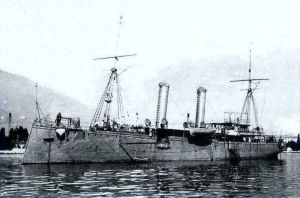 Then on 3 March he transported to Mortola Princes Frederick William, Eugene and Louis IV of Hesse and Princess Irene of Meiningen.
Then on 3 March he transported to Mortola Princes Frederick William, Eugene and Louis IV of Hesse and Princess Irene of Meiningen.
And finally on May 31st he brought to Savona the Commander of the Mediterranean Naval Squadron of the Regia Marina Vice Admiral Bertelli as well as many 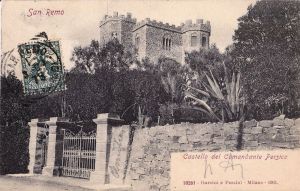 other officers.
other officers.
"The Barbarigo notice was commanded by Commander Alberto Persico who we will find again in 1899 as inhabitant of the Villa called Castle of MENELIK that he had had built in Pietralunga.
(sources: texts "Profumo di Salsedine" by Marco Macchi; images Collez. Dino Taulaigo [unless otherwise marked] ).
Year 1893
In 1893 a naval squadron of the Regia Marina visited Sanremo, in the roadstead and in the harbour. It was formed by the Battleships Lepanto, Enrico Dandolo and the Affondatore, three Cruisers and some Destroyers.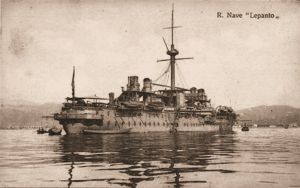
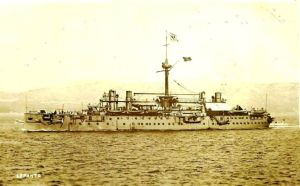 In the postcard the Battleships Lepanto, launched in 1883, was the forerunner model, together with the twin unit Italia, of battleships and for several years they were the largest and fastest warships in the world.
In the postcard the Battleships Lepanto, launched in 1883, was the forerunner model, together with the twin unit Italia, of battleships and for several years they were the largest and fastest warships in the world.
Although they became obsolete, with the advent of the quick-fire cannon, they remained among the best ships of the Regia Marina at the time.
The Battleship of the Regia Marina Enrico Dandolo participated in the Italian/Turkish War (1911/12) and the First World War.
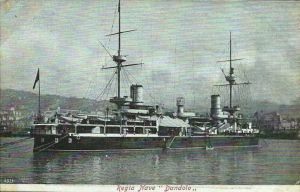
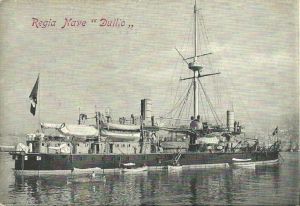 Launched in 1878 was considered, together with its twin ship Caio Duilio (photo on the right), the Naval Unit more powerful than the Epoch and together they could oppose the whole French Naval Fleet of the Mediterranean.
Launched in 1878 was considered, together with its twin ship Caio Duilio (photo on the right), the Naval Unit more powerful than the Epoch and together they could oppose the whole French Naval Fleet of the Mediterranean.
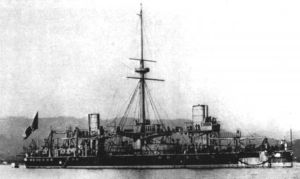 Both mounted the largest cannons that could be built at the time.
Both mounted the largest cannons that could be built at the time.
The Armored Aries in Towers of 1st Order Affondatorehad been launched in a London shipyard in 1865, had participated in the Battle of LISSA trying to spur (it had a spur of 2,50 meters!!!) the enemy ship Kaiser without succeeding.
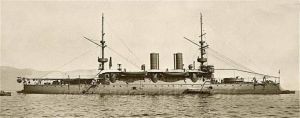 For its time it was considered a futuristic ship having only two 254/30mm. cannons, of a remarkable calibre for the time, placed on rotating turrets one at bow and one at stern.
For its time it was considered a futuristic ship having only two 254/30mm. cannons, of a remarkable calibre for the time, placed on rotating turrets one at bow and one at stern.
But she had an inadequate motor apparatus, the excessive length that slowed down the tacking on board and the centre of gravity was so high that on 6 August 1866, off the coast of Ancona, a storm sank it.
Recovered, from 1904 to 1907 it served as the main vessel in the defence of the port of Venice.
(Images and text: Dino Taulaigo)
Note by Sergio Manente:
The warships of the period, and for a long time, in fact, had the bow upside down (more advanced in keel and backward on deck) in "ancient" style from the beginning even with a "ram" below the waterline level and a reinforced bow up to the bridge where there was a rostrum sketch to avoid it to penetrate too much (and therefore to avoid it getting stuck) as for the ancient Phoenician and Roman ships.
Then they remained with a reinforced prow because the spurting technique was used for a long time (with the advent of longer range cannons and more and more technological and precise tappets).
Even in the Second World War it was a routine technique, but now it was used almost only against submarines on the surface or intent on diving, in short, against those who were defenceless or in any case poorly defended.
Year 1896
In 1896, on the occasion of the regattas for rowing boats held at the beginning of August, a naval team made up of the Corazzate Re Umberto, Lepanto, Italia. Ruggero di Lauria, the Cruisers Stromboli and Fieramosca and 19 Torpediniere visited Sanremo.
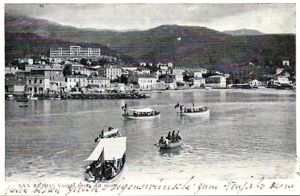 In thiese pictures you can see the crowding of people who from the east pier They wait for the boats to take them on a visit to the ships they see offshore.
In thiese pictures you can see the crowding of people who from the east pier They wait for the boats to take them on a visit to the ships they see offshore.
The Battleship Re Umberto was launched in 1888 and entered service in 1893.
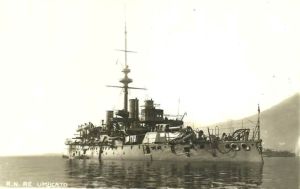
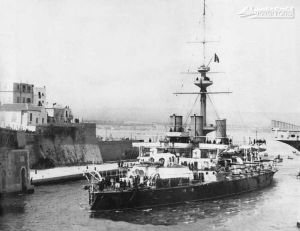 Was one of the most powerful ships of the Regia Marina until 1897, even though the long construction time had made it outdated when it came into service.
Was one of the most powerful ships of the Regia Marina until 1897, even though the long construction time had made it outdated when it came into service.
It was employed in the Italo-Turkish War (1911/12).
It was disbarred in 1914 but in 1915, re-armed, it was used as a Navigation Battery first in Brindisi and then in Valona.
Modified in 1918 and transformed into an Assault Ship to force the defences of the Austrian naval base in Pula, it was finally demolished in 1920.
Characteristics. Displacement 15.674 Tonn. at full load. Max speed 18.6 knots. Armament : 4 Bounded Pieces of 343/30 mm.16 Pieces of 120/40 mm.16 Quick Shooting Pieces of 57/43 mm.10 Quick Shooting Pieces of 37/30 mm.2 Machine Gunners. Schneider Steel Protection from 100 to 350 mm.
The Stromboli Cruiser, launched in 1886, initially classified as a Destroyer Torpedo Aries at launch was reclassified as 2nd Class Armored Cruiser.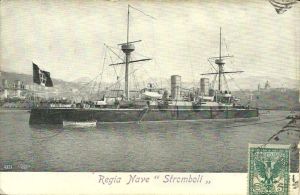
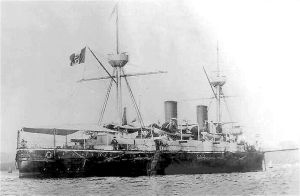 It underwent important modifications in 1900 and 1907 to improve its calibre, range and increase the shooting rate.
It underwent important modifications in 1900 and 1907 to improve its calibre, range and increase the shooting rate.
But he was disbarred in 1907.
Features. Displacement 3950 Tonn. p. c. Max speed 16,60 knots. Armament: 2 Single Pieces 255/30 mm.6 Single Pieces 152/40 mm.6 Single Pieces 152/40 mm.6 Single Pieces 57/40 mm.8 Single Pieces 37/20 mm.2 Machine Guns MG3 Tube Throwers 355 mm.
The Armored Battleship of 1st Class Ruggero di Lauria, the image of which portrays it while it is in the roadstead in Sanremo.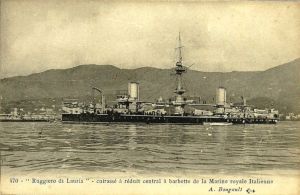 Was launched in 1884 and was a derivative of the Caio Duilio Class Units, representing a regression. compared to the development of contemporary Battle Ships.
Was launched in 1884 and was a derivative of the Caio Duilio Class Units, representing a regression. compared to the development of contemporary Battle Ships.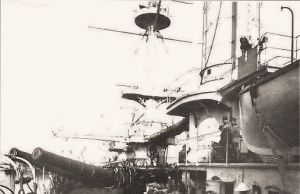
Serviced from 1888 to 1911.
After the Radiation it was used as a fuel depot in the port of La Spezia. until 1943.
Bombed by Allied planes it sank in shallow waters and was recovered in the Second World War. to be demolished in 1947.
Features. Displacement 14,726 tons p.c. Max speed 16 knots. Armament : 4 Binary Pieces of 431/27 mm.2 Single Pieces of 152/32 mm.4 Single Pieces of 120/32 mm.2 Single Pieces of 75 mm.10 Pieces of 57 mm.17 Pieces of 37 mm.5 Tube Throwers of 450 mm.
(Dino Taulaigo Collection)
Year 1899
In 1899, from 19th to 22nd August, the English Mediterranean Fleet visited Sanremo. It was commanded by Admiral Noel and was composed of the Revenge, Royal Oaks, Caesar, Illustrious, Hood, Ramilles, Empress of India, Anson and 4 Cruisers.
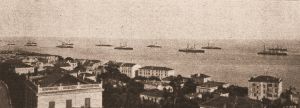 The visit was motivated by the fact that Queen Victoria, who was staying in Menton, had to move to Bordighera where she was expected by the numerous English Colony.
The visit was motivated by the fact that Queen Victoria, who was staying in Menton, had to move to Bordighera where she was expected by the numerous English Colony.
But she was prevented from doing so by the outbreak of the Anglo-Boer War which forced her to return home.
(Dino Taulaigo Collection)
The '800 was coming to an end but new naval teams returned to visit Sanremo also in the new century 1900.
Year 1905
In 1905, in August, a naval team of the Regia Marina including the Armored Cruisers Varese, Vettor Pisani, and Carlo Alberto dropped anchor in the bay of Sanremo, while other units of the Squadron were available from Ventimiglia to Diano Marina.
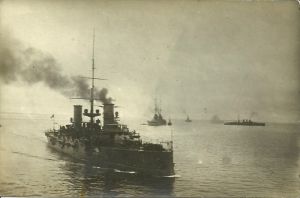 The Armored Cruiser Varese was launched in 1899, built by the Orlando Shipyard in Livorno and entered service in 1901 and was an excellent unit both in terms of design and construction.
The Armored Cruiser Varese was launched in 1899, built by the Orlando Shipyard in Livorno and entered service in 1901 and was an excellent unit both in terms of design and construction.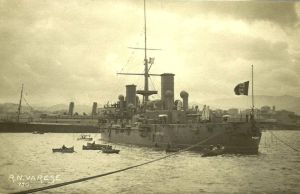 It was an intermediate model between the Battleship and the Cruiser, combining the firepower of the former with the speed and manoeuvrability of the latter. It was, as they say, such a successful model that several Foreign Marines bought it in the same class.
It was an intermediate model between the Battleship and the Cruiser, combining the firepower of the former with the speed and manoeuvrability of the latter. It was, as they say, such a successful model that several Foreign Marines bought it in the same class.
The Varese Ship participated in the Italo-Turkish War and from 1920 to 1922 was used as a school ship for the students of the Naval Academy.
It was finally disbarred in 1923.
Characteristics : Displacement 8.100 tons p.c. Speed 20 knots. Case hardened steel protection Harvey system from 38 mm.(bridge) to 150 mm. (tower and artillery shields) Armament: 2 pieces of 203/45 mm. 1 Piece from 254/40 mm. 14 pieces of 152/40 mm. 10 pieces from 76/40 mm. 6 pieces Hotchkiss MK 1 from 47/50 mm. 2 Gunner Maxim MG, 4 Tubes Torpedo Launcher 450 mm. Crew 549 permanent effective, complement 1200.
As mentioned above, it was such a successful model that Argentina commissioned four of them: 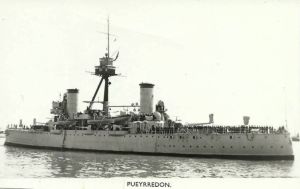
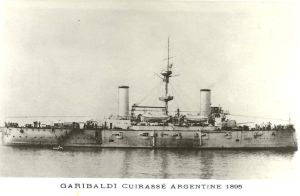 General Garibaldi, General San Martin, General Belgrano and Pueyrredon.
General Garibaldi, General San Martin, General Belgrano and Pueyrredon.
Japan two : Nisshin and Kasuga. Spain one : Cristobal Colon.
Italy was incredibly the last with Giuseppe Garibaldi, Francesco Ferruccio and of course Varese.
Here at the sides the Argentine ships, derived from the Varese.
The Armored Cruiser Vettor Pisani (Vettor Pisani and not Vittor Pisani as erroneously written on the photo) was launched in 1895 and was completed in 1899.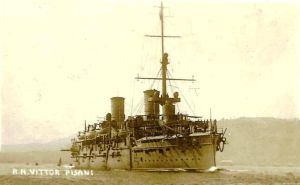 Equipped with a sea hull and a maneuverer, it was deficient in weaponry in terms of calibre, type and arrangement of the pieces.
Equipped with a sea hull and a maneuverer, it was deficient in weaponry in terms of calibre, type and arrangement of the pieces.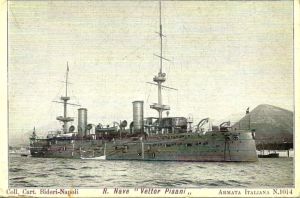 It distinguished itself from the Head of Class Carlo Alberto for the presence of the main mast, in addition to the foremast, among which in 1902 Guglielmo Marconi laid the antennas for the first experiments in long distance radio transmission.
It distinguished itself from the Head of Class Carlo Alberto for the presence of the main mast, in addition to the foremast, among which in 1902 Guglielmo Marconi laid the antennas for the first experiments in long distance radio transmission.
In 1900 it was sent to China with landing troops to protect the Italian Legation and European interests during the Boxers' Uprising.
It also took part in the Italo-Turkish War and in 1911 it took part in the conquest of Libya.
Note how the second picture of Vettor Pisani is a picture after modifications because one tree has been removed, while the other has two trees right where Marconi did his experiment.
Characteristics Displacement 7128 tons fully loaded. Speed 18.60 knots. Protection from 37mm.(bridge) to 150mm. (belt, artillery, tower). Armament : 12 pieces from 152/40 mm. 4 pieces from 120/40 mm. 14 pieces from 57/40 mm. 8 pieces from 37/20 mm. 2 MG Machine Gunners 2 Pieces of 75mm. 5 Tubes Tube Throwers 450 mm.
The Armored Cruiser Carlo Alberto was launched in 1896 and went into service in 1898.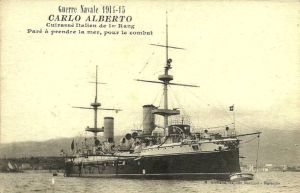
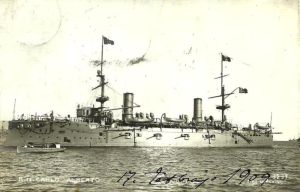 Like the Vettor Pisani, it had deficiencies in armament by calibre, type and layout.
Like the Vettor Pisani, it had deficiencies in armament by calibre, type and layout.
He took part in the Italo-Turkish War.
It was transformed in 1917 /1918 into a Troop Transport Ship and took the name Regia Nave Zenson.
It was disbarred in 1920.
Characteristics Displacement 7170 tons p.c. Speed 19.50 knots. Armament : 12 pieces of 152/40 mm. 6 pieces of 120/40 mm. 2 pieces of 75 mm. 10 pieces of 37 mm. 10 pieces of 57 mm. 2 machine-guns 5 tubes of 450 mm.
(sources : for the notes "Profumo di Salsedine" by Marco Macchi and "Bozzo Navi da Guerra Archives"; images from postcards from the Dino Taulaigo Collection).
Year 1910
In 1910 a Regia Marina's naval squadron came to Sanremo, composed by the Armored Cruisers Giuseppe Garibaldi, Francesco Ferruccio and Amalfi, under the command of Admiral Nicastro, who promised that he would return with the whole squadron.
(NOTE: The visits of the Regia Marina's units culminated with great receptions in the luxurious hotels of the city and were an opportunity to liven up the worldly life and at the same time the people of Sanremo ran to visit the ships)
The Armored Cruiser Giuseppe Garibaldi was set in 1898, launched in 1899 and completed and in service in 1901.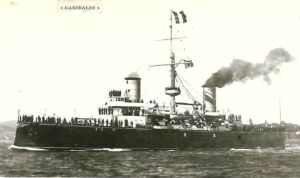 It was one of the most modern ships of the time, it had a steel hull and had been built by the Ansaldo Shipyards in Genova Sestri.
It was one of the most modern ships of the time, it had a steel hull and had been built by the Ansaldo Shipyards in Genova Sestri.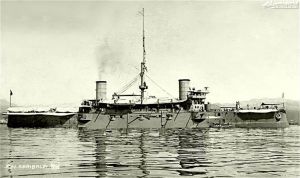 It was a hybrid between the Cruisers and the Battle Ships, slower than the former, however had the armament of the second one.
It was a hybrid between the Cruisers and the Battle Ships, slower than the former, however had the armament of the second one.
Suitable for team combat, it had good speed to escape superiority. of the opponents.
This type of ship was very successful and, as said for the Varese, ten by four units were built several National Marines.
He was employed in the Italo-Turkish War in the waters of Libya, the Aegean and the Levant and on 24th February 1912 with his twin sister Francesco Ferruccio sank a Turkish gunboat in the waters of Beirut.
It was sunk on 18 July 1915 by the torpedo of an Austrian U-4 submarine during the cannon fire of the Ragusa - Kotor railway.
(Characteristics Dislocamento a p.c. 8100 tons. Speed 19.70 knots 38 mm Harvey case-hardened steel protection. (bridge) to 150 mm.(artillery shields, belt, tower) Armament : 1 piece of 254/40 mm. 2 pieces of 203/45 mm. 14 pieces of 152/40 mm. 10 pieces of 76 mm. 6 pieces Hotchkiss Mk 1 of 47/50mm. 2 gunner Maxim MG 4 tubes of 450mm.)
The Armored Cruiser Amalfi, Pisa Class was built in the Odero, Foce, Genova Shipyards. 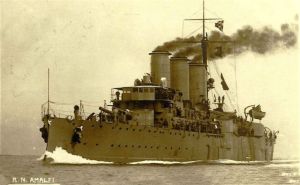 Set in 1905, it was launched in 1908 and completed in 1909.
Set in 1905, it was launched in 1908 and completed in 1909.
With the Twin Unit Pisa formed the last generation of powerfully armed Cruisers. 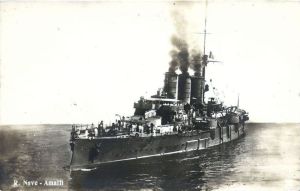
However, shortly afterwards these Units were overtaken by the Battle Cruisers.
In 1911 it participated in the Italo-Turkish War in the Dardanelles, Cyrenaica, Tripolitania and the Aegean Sea, supporting the landings and occupations of the Dodecanese Islands of Stampalia and Patmos.
When Italy entered the war on 24 May 1915 it was transferred to Venice to support the troops operating on that front.
On 7 July 1915 she went out to sea, with other Units, to carry out an exploratory mission in the Northern Adriatic Sea and was torpedoed by the German submarine U-26 which operated with German personnel under the Austro-Hungarian flag.
The watertight compartments suitable to resist the weapons at the beginning of the century were ineffective for the 450 mm. torpedo with a 140 kg. charge launched by the submarine. It sank in a few minutes and 67 men of the crew died.
(Characteristics Displacement 10,401 tons p.c. Speed 23.6 knots Vickers steel protection from 51mm (deck) to 200mm (belt). Armament : 4 pcs twinned IT mod.1906 from 254/45 mm. 8 twinned pieces C 1908 from 190/45 mm. 16 single pieces C 1911 from 76/40 mm 2 pieces from 47 mm. 2 machine guns 3 torpedo tubes of 450 mm.)
The Armored Cruiser Francesco Ferruccio was set in 1899, launched in 1902 and completed and in service in 1905. 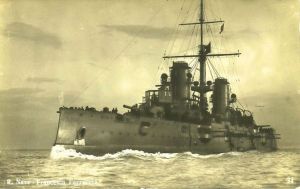 It operated in the Italian-Turkish War in the waters of LIbia, the Aegean and the Levant and with Giuseppe Garibaldi participated in the Turkish gunboat
It operated in the Italian-Turkish War in the waters of LIbia, the Aegean and the Levant and with Giuseppe Garibaldi participated in the Turkish gunboat 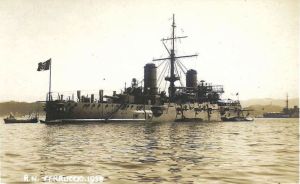 sinking in the waters of Beirut.
sinking in the waters of Beirut.
He was employed from 1924 to 1929 as a school ship for the students of the Naval Academy.
It was disbarred in 1930 and demolished in 1931.
(Characteristics of the Ship: Same characteristics as the Armored Cruiser Giuseppe Garibaldi being a Twin Unit.)
(Text and images from Coll.ne Dino Taulaigo)
Year 1911
In 1911, in anticipation of the Italian-Turkish War (also known as the Libyan War), the fleet of the Italian Royal Navy carried out landing exercises in Diano Marina in the Ligurian Sea.
Under the command of the Amiraglio Aubry, in addition to the units already mentioned above, came to Sanremo, the Battleships Vittorio Emanuele I, Regina Elena, Naples, Rome, Benedetto Brin, the Armored Cruisers Pisa and Amalfi, the Destroyer Cruiser (then Explorer) Coatit and sixteen Destroyers, including the Corazziere and the Lanciere.
It was the most numerous presence of naval units in roadsteads in Sanremo before the First World Conflict and it attracted many spectators, large and small!
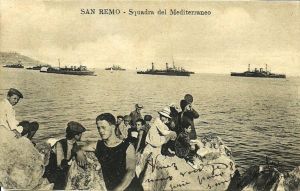 In the picture on the postcard we can see the Battleship Benedetto Brin, the Armored Cruiser Amalfi, the Destroyer Cruiser Coatit, the Armored Cruiser
In the picture on the postcard we can see the Battleship Benedetto Brin, the Armored Cruiser Amalfi, the Destroyer Cruiser Coatit, the Armored Cruiser 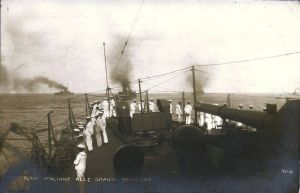 Pisa and some Destroyers of the Grenadier Class (or rather Soldier Class) lined up from right to left.
Pisa and some Destroyers of the Grenadier Class (or rather Soldier Class) lined up from right to left.
The Battleship at revolving towers Vittorio Emanuele I was built in the Shipyards of Castellammare di Stabia, launched in 1904 and entered service in 1908.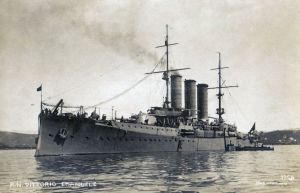
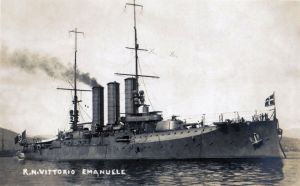 It was considered an excellent unit with characteristics well balanced between the need for less tonnage, maximum protection and armament power. It was built to effectively combat the new French Armored Cruisers but was faster than the English and French Battle Ships of the Epoch, and more armed than the Cruisers.
It was considered an excellent unit with characteristics well balanced between the need for less tonnage, maximum protection and armament power. It was built to effectively combat the new French Armored Cruisers but was faster than the English and French Battle Ships of the Epoch, and more armed than the Cruisers.
These Units were the forerunners of the New Battleships adopted by all Marines.
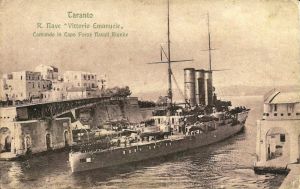 Originally equipped with 2 masts, following modernisation in 1912, one was removed.
Originally equipped with 2 masts, following modernisation in 1912, one was removed.
It took part in the Italo-Turkish War and the First World War.
From July 1922 it was classified as "Coastline Battleship" until the Radiation of 1923.
The Vittorio Emanuele I in Taranto is passing by the Ponte Girevole bridge that connects the Mare Grande with the Mare Piccolo.
At that time it was the headquarters of the Command in Capo delle Forze Navali Riunite.
(Features. Class Regina Elena... Displacement p.c. 14,137 tons. Max forced speed 21.36 knots... Steel Terni protection 50mm. (battery bridge) to 250 mm. (tower, towers, belt)... Armament: 2 Single pieces of 305/40 mm.; 12 twin pieces of 203/45 mm.; 16 single pieces of 76 mm.: 10 single pieces of 47 mm.; 2 machine guns; 2 torpedo tubes of 450 mm.).
The Battleship Regina Elena, Unit "Head of the class", was built in the shipyard of the Arsenal of La Spezia to be launched in 1904 and entered into service in 1907.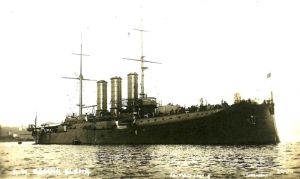
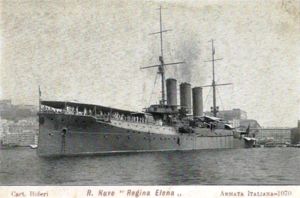 It took part in the Italo-Turkish War (Libyan War) and the First World War.
It took part in the Italo-Turkish War (Libyan War) and the First World War.
In the first post-war period it was used as a departmental flagship and as a school ship.
From 1927 it served as a Training Unit until it was cancelled from the Regia Marina Registers in 1932.
(Characteristics : Full load displacement 13,804 tons. Speed: 20.8 knots. Protection and Armament the same as the Gemella Vittorio Emanuele I°. (for Technical Notes the same as for Gemella Vittorio Emanuele I°).
The Battleship at revolving towers Napoli, also Regina Elena Class, was built in Castellammare di Stabia, launched in 1905 and entered service in 1908.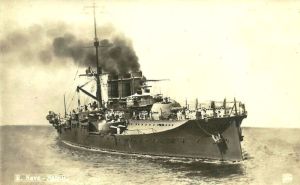
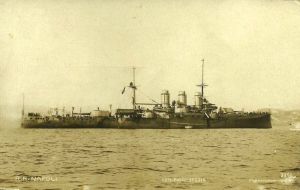 He took part in the Italo-Turkish War and the First World War.
He took part in the Italo-Turkish War and the First World War.
In 1926 it was cancelled by the Registers of the Navy and sold to the breakers.
It was dismantled in Savona in 1928.
(Dislocamento p.c. 13,995 tons. Max forced speed 22.40 knots. Protection and Armament the same as the Vittorio Emanuele I°. Technical notes the same as Vittorio Emanuele I).
The Battleship Benedetto Brin was built by the Shipyards of Castellammare di Stabia to be launched in 1901 and to enter into service in 1906.
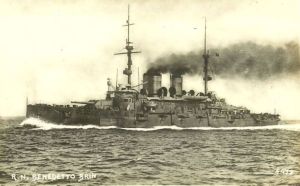 It was an Excellent Unit for its Speed, High Protection, Good Armament, Excellent Marine Quality combined with a more comfortable accommodation for the crew.
It was an Excellent Unit for its Speed, High Protection, Good Armament, Excellent Marine Quality combined with a more comfortable accommodation for the crew.
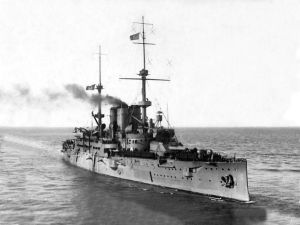 It sank on 20th September 1915 in the port of Brindisi for enemy sabotage.
It sank on 20th September 1915 in the port of Brindisi for enemy sabotage.
454 men of the crew died, including the Commander of the 3rd Naval Division and the Commander of the Ship.
(Characteristics : Displacement 14,974 tons p.c. Speed 20 knots. Protection from 80 mm (bridge) to 220 mm. (artillery). Armament : 4 pieces of 305/40 mm.; 4 pieces of 203/45 mm.; 12 pieces of 152 mm.: 20 pieces of 76 mm.; 2 pieces of 47 mm.; 2 pieces of 37 mm.; 2 gunners of 10 mm., 4 tubes of 450 mm.).
The Battleship at revolving towers Roma, (class Regina Elena), was built in the Arsenal Shipyard of La Spezia to be launched in 1907 and entered into service in 1908.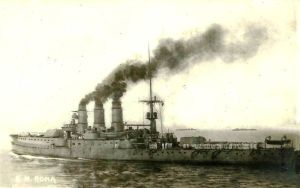
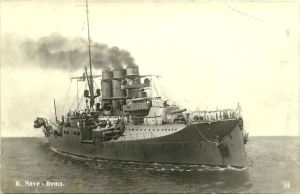 It took part in the Italo-Turkish War and the 1st World War.
It took part in the Italo-Turkish War and the 1st World War.
It was cancelled by the Registers of the Navy in 1928 and demolished in 1932.
(Another image of the Corazzata Roma. The resemblance with Napoli is impressive !).
(Characteristics of the Ship. Displacement and speed the same as the Corazzata Napoli. Protection and Armament the same as the Corazzata Vittorio Emanuele I).
The Destroyer Cruiser Coatit built in Castellammare di Stabia was launched in 1899 and entered service in 1900.
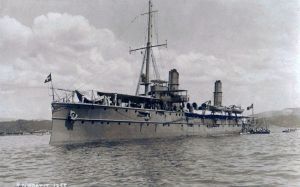 Designed as a Torpedo Destroyer, after modifications made in 1914, it was reclassified as the "Torpedo Destroyer Explorer".
Designed as a Torpedo Destroyer, after modifications made in 1914, it was reclassified as the "Torpedo Destroyer Explorer".
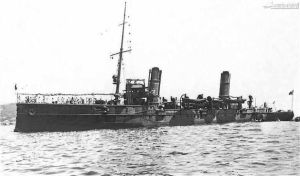 However, due to the low speed developed as an Explorer, it had little success.
However, due to the low speed developed as an Explorer, it had little success.
Originally it was equipped with 2 Trees but later one was removed.
It differed from the twin Unit Agordat because of the shorter funnels. In 1919 it was transformed into Mine cutter ship.
From June 1903 to February 1904 it was deployed in the Red Sea and East Africa to combat piracy.
It took part in the Italo-Turkish War and the First World War. It was disbarred in 1920.
(Features: Agordat Class. P.C. displacement 1.510 tons. Speed 23 knots. Protection 20 mm. (bridge). Armament : 12 single pieces of 76/40 mm.; 2 torpedo tubes of 450 mm.).
The Armoured Cruiser Pisa (twin of Amalfi), was built in the Orlando Shipyards in Livorno and was launched in 1907, entering service in 1911 (before the beginning of the outbreak of the Italo-Turkish War).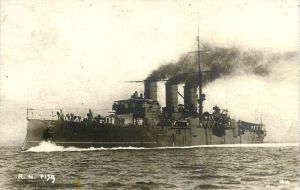 So when he came to Sanremo he had just entered into service.
So when he came to Sanremo he had just entered into service.
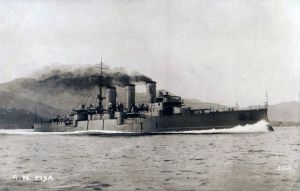 As already said for Amalfi, it was the last generation of large and powerfully armed Cruisers. However, they were soon overtaken by the Battle Cruisers.
As already said for Amalfi, it was the last generation of large and powerfully armed Cruisers. However, they were soon overtaken by the Battle Cruisers.
He took part in the Italo-Turkish War (War of Libya) in 1911.
On 24th May 1915 he was transferred to Venice to support the troops operating on land in that area.
In 1921 it was reclassified as "Corazzata Costiera" (Coastal Battleship) and after modification works it was transformed, from 1925 to 1930, into a school ship for the students of the Naval Academy.
(Characteristics : Displacement p.c. 10,401 tons. Speed 23.3 knots. 51 mm Vickers steel protection. (bridge) to 200 mm. (belt). Armament : 4 twinned pieces IT mod. 1906 from 254/45 mm.; 8 twinned pieces C 1908 from 190/45 mm.; 16 single pieces C 1911 from 76/40 mm.; 2 pieces from 47 mm.; 2 gunners; 3 torpedo tubes from 450 mm.).
Among the 16 Destroyers present in the roadstead there were some in the Soldier Class
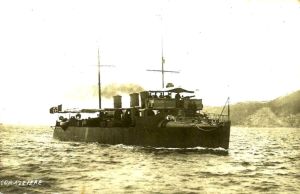 It was a Class designed and built by Cantieri Ansaldo di Genova. Units that were successful, stable, fast and with good manoeuvrability.
It was a Class designed and built by Cantieri Ansaldo di Genova. Units that were successful, stable, fast and with good manoeuvrability.
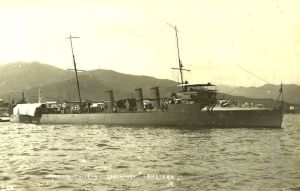 All the Units survived World War I with the exception of the Garibaldi Ship which sank in Villafranca in July 1918 due to a collision with an English warship.
All the Units survived World War I with the exception of the Garibaldi Ship which sank in Villafranca in July 1918 due to a collision with an English warship.
All the remaining Units were downgraded to "Torpedo boats" starting from the 1st July 1921 and disbanded between 1925 and 1930.
Images of the Destroyers Corazziere and Lanciere units of the Class Soldier subclass Artilleryman.
(Characteristic : P.C. displacement 415 tons. Speed : 28.50 knots. Armament : 4 pieces of 76/40 mm.; 3 torpedo tubes of 450 mm.).
(text and images from Dino Taulaigo Collection)
Year 1921
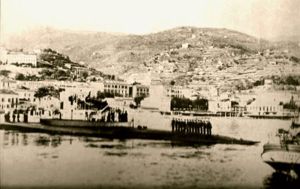 In 1921 a squadron of submarines came to visit Sanremo and Queen Helena also went to visit them.
In 1921 a squadron of submarines came to visit Sanremo and Queen Helena also went to visit them.
(The image is taken from a poster of the National Sailors' Association of Italy and the photo from which it is taken is from the Gino Guglielmi collection. It is dated 1920 but it could be one of the Submarines visiting Sanremo in 1921).
In the same year, a Naval Squadron made up of three Battleships appeared in our roadstead: Giulio Cesare, Andrea Doria and Caio Duilio with the escort of five destroyers.
The Squadron was commanded by Admiral Nicastro, who had already visited Sanremo eleven years before and had promised to return with another Squadron. And so he did!
The Battleship Andrea Doria (Class Caio Duilio), was the first of the Naval Squadron to arrive in the roadstead.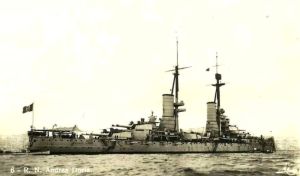
 Set in 1912, launched in 1913, it was completed and entered service in 1916, then completely rebuilt in 1940.
Set in 1912, launched in 1913, it was completed and entered service in 1916, then completely rebuilt in 1940.
Built on a project elaborated by General Valsecchi, derived from the Conte di Cavour Class, it was built in the Arsenal of La Spezia.
In 1920 it was sent on a military political mission in Albanian and Dalmatian waters on the occasion of the occupation of Rijeka by GabrieleD'Annunzio.
In 1923 it took part in the occupation of Corfu follow-up of friction between Italy and Greece for the massacres of Janina.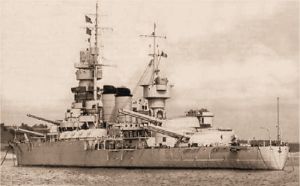 From 1937 to 1940 it underwent radical transformation works. Extended by 11 metres, new motorization was mounted and the towers for the new pieces were rebuilt. After the transformation works carried out in the Cantieri Riuniti dell'Adriatico in Trieste, she returned to the Squadron in October 1940.
From 1937 to 1940 it underwent radical transformation works. Extended by 11 metres, new motorization was mounted and the towers for the new pieces were rebuilt. After the transformation works carried out in the Cantieri Riuniti dell'Adriatico in Trieste, she returned to the Squadron in October 1940.
He took part in numerous war operations including the "First Battle of the Sirte" in 1941 and the escort of convoys to North Africa.
During the last 18 months of the war he remained inactive due to lack of fuel. After the Armistice of 8th September 1943 she went to Malta and was interned by the Allies.
With the Peace Treaty of 1947 she returned to Italy and became Headquarters of the Squadron until she was disarmed and disbanded in 1956.
It was demolished between 1957 and 1961.
(Technical Characteristics: Displacement: originally 25,200 tonnes fully loaded, reconstructed 29,200 tonnes p. c.; Speed: originally 21.50 knots, reconstructed 27 knots; Autonomy: originally 4800 miles at 10 knots, reconstructed 3390 miles at 20 knots.; Protection: originally 250 mm. belt, 97 mm. bridge, 280 mm. towers, 280 mm. tower. Rebuilt belt 250 mm., bridge 140 mm., towers 280 mm., tower 260 mm.; Armament: originally 13 pcs. 305/46 mm, 16 pcs. 152/45 mm, 13 pcs. 76/45 mm, 6 pcs. 76/40 mm, 2 pcs. 40/39 mm, 6 machine guns, 2 torpedo tubes 450 mm.; After rebuilt: 6 pieces Trinati in 2 towers of 320/44 mm., 4 pieces Binati in 2 towers of 320/44 mm., 12 p. Trinati in 4 towers of 135/45 mm.,10 p. single pieces of 90/50 mm.,19 single pieces of 37/54 mm., 12 single pieces of 20/65.; Crew: originally 1005 permanent effective, rebuilt 1495 permanent effective).
The Battleship Caio Duilio, twin ship of Andrea Doria, was built in the Shipyards of Castellammare di Stabia to be launched in 1913 and entered into service in 1915.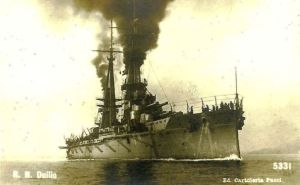 Disbarred and disarmed in 1956, it was demolished in 1957/ 1961.
Disbarred and disarmed in 1956, it was demolished in 1957/ 1961. 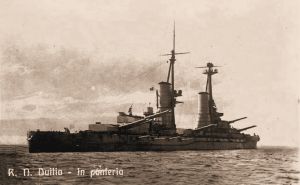 Designed and built like its Twin, from 1937 to 1940 it too underwent radical structural and armament transformation works at the Genoa Tyrrhenian Sea Shipyards.
Designed and built like its Twin, from 1937 to 1940 it too underwent radical structural and armament transformation works at the Genoa Tyrrhenian Sea Shipyards.
Extended by 11 metres, new motorization was mounted and the towers were rebuilt for the new pieces.
The works lasted until May 1941 and resumed service in Taranto in July of the same year.
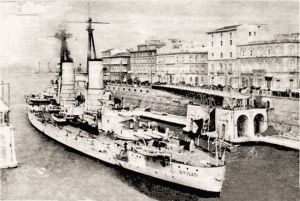 Not yet operational, it did not take part in the "Battle of Punta Stilo" on 9th July 1940.
Not yet operational, it did not take part in the "Battle of Punta Stilo" on 9th July 1940.
It was the object of the torpedo launch in the "the Battle of Taranto" between 11 and 12 November 1940, also known as "the Night of Taranto".
It underwent an 11 X 7 metres breach near the ammunition depot at Prua and was stranded in shallow water to prevent it from sinking.
It participated between November 1940 and January 1941 in the anti-aircraft defence of the stronghold.
In January 1941 it was afloat again and on 3rd February it entered the Basin in Genoa. The works lasted until May 1941 and resumed service in Taranto in July 1941.
After the Armistice of 8th September 1943 she went to Malta and was interned by the Allies.
After the Peace Treaty she returned to Italy and from 1947 to 1949 became the headquarters of the Naval Command.
It was transferred to La Spezia in 1953 until September 1956 when it was disarmed and then demolished.
(Characteristics of the Ship: Andrea Doria Class. Displacement at the origin and after the reconstruction, speed at the origin and after the reconstruction, protection at the origin and after the reconstruction, armament at the origin and after the reconstruction the same of the Andrea Doria).
The Battleship Giulio Cesare was built at the Ansaldo Shipyards in Genoa to be launched in 1911 and completed in 1914.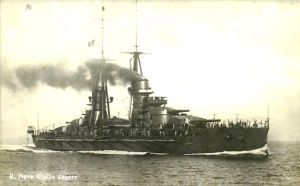 The doubts of its designer, General Masdea, about the efficiency of the superimposed towers were set aside and these were mounted for the first time on the Cavour Class ships.
The doubts of its designer, General Masdea, about the efficiency of the superimposed towers were set aside and these were mounted for the first time on the Cavour Class ships.
It was unusual, for the time, the view of twin towers mounted on trinate towers.
Having survived the First World War, the Conte di Cavour and Giulio Cesare were rebuilt in the 1930s.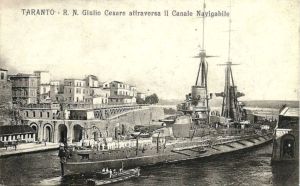 In 1923 it was used against the Island of Corfu' because of the Italian / Hellenic Crisis after the massacre of Italian Delegate Officers in Janina.
In 1923 it was used against the Island of Corfu' because of the Italian / Hellenic Crisis after the massacre of Italian Delegate Officers in Janina.
In 1933 it was transferred to the Genoa Tyrrhenian Sea Shipyards to be rebuilt at 60%, the equipment was updated, the displacement, the power of the engine and the speed increased.
In 1940 she took part in the "Battle of Punta Stilo" (she was hit by a grenade from the English Battleship Warspite) and the "Battle of Cape Teulada".
In 1941 she took part in the "First Battle of the Sirte".
On 11 September 1943 she sailed from Pula to Taranto and finally to Malta where she remained until the end of the Conflict.
In 1949 she was disbarred and ceded to the USSR and took the name Novorossiysk.
On the 30th October 1954 it sank in the port of Sevastopol officially because of a German mine but it seems that the cause was sabotage.
(Characteristics of the ship: displacement p.c. 25,086 tons. Speed: 21.50 knots. Armament: 13 pieces of 305 /46 mm.; 18 pieces of 120 /50 mm.; 16 pieces of 76/50 mm.; 6 pieces of 76/40 mm.; 3 tubes of 450 mm.).
The following two pictures are two postcards taken just in 1921, during the visit of you spoke above.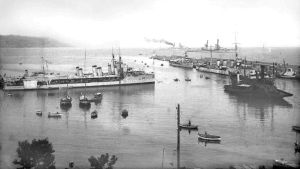 We would like to point out that the two Armored ships in the roadstead are the Andrea Doria and the Giulio Cesare
We would like to point out that the two Armored ships in the roadstead are the Andrea Doria and the Giulio Cesare
Moored at the east pier are the Destroyers La Masa (optical identification code on the LM side) and La Farina.
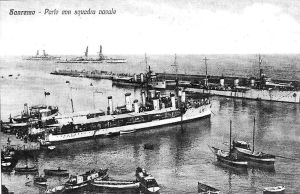
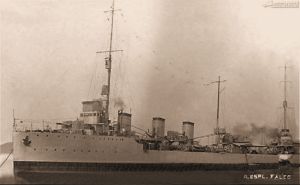 Moored at the long western pier are the Destroyers Premuda and Fabrizi and the Explorer Falco.
Moored at the long western pier are the Destroyers Premuda and Fabrizi and the Explorer Falco.
(Text and images from Coll.ne Dino Taulaigo)
Year 1929
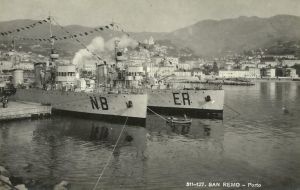 In 1929, despite the fact that over the years the number of visits had been reduced, at the beginning of June, for the Feast of the Statute (and for this reason the Gran Pavese is displayed), the Destroyers of the Regia Marina Nembo and Euro arrived in port, returning from a cruise in Spain and accompanied by the Navy Musical Band.
In 1929, despite the fact that over the years the number of visits had been reduced, at the beginning of June, for the Feast of the Statute (and for this reason the Gran Pavese is displayed), the Destroyers of the Regia Marina Nembo and Euro arrived in port, returning from a cruise in Spain and accompanied by the Navy Musical Band.
In the same year also the submarine of the Regia Marina Giovanni da Procida visited Sanremo.
It too "exhibits" the Gran Pavese and may have been part of the Naval Team that visited at the beginning of June, for the Feast of the Statute, with the Caccia Nembo and Euro and the Cruisers Pesanti Trento and Trieste.
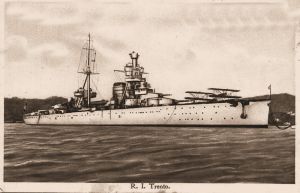 The Trento Heavy Cruiser had been built in the Orlando Shipyards in Livorno to be launched in 1927 and entered into service in 1929 (so when he came to visit Sanremo he was "fresh" from Service!!!).
The Trento Heavy Cruiser had been built in the Orlando Shipyards in Livorno to be launched in 1927 and entered into service in 1929 (so when he came to visit Sanremo he was "fresh" from Service!!!).
It was the first Unit built in Italy respecting the limitations of the Treaty of Washington.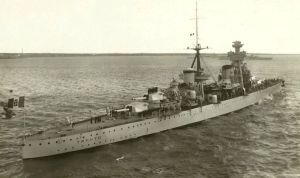 It turned out to be a fast Unit but not very protected and not easy to handle.
It turned out to be a fast Unit but not very protected and not easy to handle.
In 1937 it underwent important modifications in the armament.
In 1940 it took part in the "Battle of Punta Stilo" and the "Battle of Capo Spartivento".
On 11th November 1940 it suffered an air attack in the port of Taranto, the tragic "Night of Taranto", by the British Air Force who studied Japanese tactics at Peral Harbour.
In 1941 he took part in the "Battle of Cape Matapan" and the destruction of an enemy naval convoy of 7 ships.
It was sunk, in 1942, by a torpedo launched by a British submarine.
(Characteristics : Displacement p.c. 13,548 tons. Speed 35 knots. 50 mm protection. (bridge) to 100 mm. (Tower and Artillery). Armament: 8 Pieces of 203/50 mm.; 16 Pieces of 100/47 mm.; 4 Machine guns of 40/39 mm.; 4 Machine guns of 12,7 mm.; 8 Torpedo tubes of 533 mm.; 3 PIAGGGIO aeroplanes P 6)
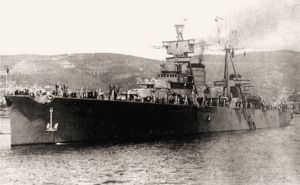 The Trieste Heavy Cruiser (Twin Unit of Trento) was built at the Trieste Technical Plant, set up in 1925, launched in 1926 and also entered service in 1929.
The Trieste Heavy Cruiser (Twin Unit of Trento) was built at the Trieste Technical Plant, set up in 1925, launched in 1926 and also entered service in 1929.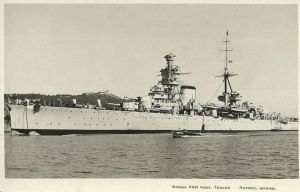 In May 1929 it completed a cruise from La Spezia to Barcelona together with the Trento. In 1935 she was temporarily the flagship of the 3rd Division (a role usually assigned to the Trento).
In May 1929 it completed a cruise from La Spezia to Barcelona together with the Trento. In 1935 she was temporarily the flagship of the 3rd Division (a role usually assigned to the Trento).
During the Second World War, from the first months of 1940 until 10 April 1943, when she was sunk, she carried out several missions, taking part in some of the main operations and battles in the Mediterranean Sea and carrying out indirect convoy escort missions, with no significant success.
On the contrary, on 21st November 1941, while she was at sea (together with Trento, Gorizia and the VIII Division), escorting a convoy to Libya, she was hit by a torpedo launched by the submarine HMS Utmost. It suffered serious damage that immobilized it and only after an hour and a half it was possible to leave again to return to Messina with difficulty.
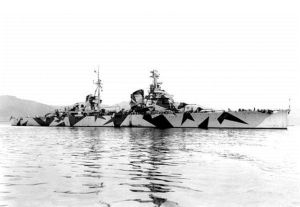
After the repairs it received a camouflage livery.
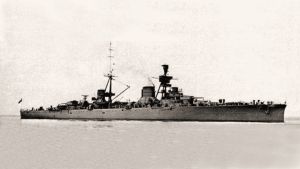 On 10th April 1943, while it was at anchor on La Maddalena, the base was attacked by 84 U.S. bombers targeting Trieste and Gorizia as well as submarines.
On 10th April 1943, while it was at anchor on La Maddalena, the base was attacked by 84 U.S. bombers targeting Trieste and Gorizia as well as submarines.
The Trieste was hit by more than 120 bombs which caused its sinking with the loss of 77 men.
Its wreck was recovered in 1950 and sold to Spain who wanted to use it, rebuilding it as an aircraft carrier, but the project was not followed and the hull was later demolished.
(Technical characteristics: Displacement p.c. 13.885 tons; Speed and Armament as for the Trento.)
(photo Dino Taulaigo and additional information taken from external sources)
Year 1938
In 1938 the 1st Class Battleship of the British Royal Navy Qeen Elizabeth visited Sanremo.
She was a Class Captain Unit and to her Class belonged the Valiant, the Barham, the Warspite and the Malay.
It was launched in 1913 and entered service in 1915.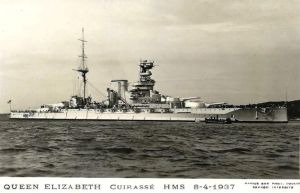 This Class of Units was built to bring great fire cover to the first front of the enemy naval battle line with a mix of high speed and firepower appropriate to tonnage.
This Class of Units was built to bring great fire cover to the first front of the enemy naval battle line with a mix of high speed and firepower appropriate to tonnage.
On 19th February 1915 it bombarded the Turkish coastal defences of the Dardanelles and was hit by enemy cannon fire without serious damage.
On 27th April 1915 she opened fire on the former Germanica Goeben using a braking balloon to locate it.
From 1919 it became the flagship of the Atlantic Fleet and from 1924 it became part of the Mediterranean Fleet.
Rebuilt at the beginning of the Second World War, it was aggregated to the Mediterranean Fleet.
On 18th December 1941, in the port of Alexandria was attacked by the "Maiale" (An amphibious torpedo) of the Italian Royal Navy led by Marcegaglia and Schergat, while another "Maiale", led by Durand De La Penne and Bianchi sank the twin ship HMS Valiant and a third "Maiale", led by Martellotta and Marino sank an oil tanker and the Destroyer HMS Jervis.
Recovered by the Americans and repaired at Norfolk in Virginia, it was put into service in 1944, in the Pacific, taking part in the bombing of Japanese bases in Indonesia.
She was disarmed in 1945, disbarred in 1946 and demolished in 1948.
(Ship characteristics: Normal displacement 36,450 tons. Speed 23.50 knots. Krupp type casehardened steel protection from 50 mm (upper deck) to 280 mm. (tower). Armament: 4 twinned pieces of 381/42 mm.; 14 single pieces of 152/45 mm.; 2 quick fire single pieces of 76/45 mm.; 10 single pieces of 76/26 mm.; 4 single pieces of 47 mm.; 4 torpedo tubes of 534 mm.).
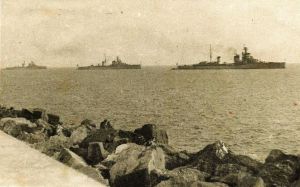 In the same year, between 25 and 28 February, a Regia Marina Naval Squadron visited Sanremo.
In the same year, between 25 and 28 February, a Regia Marina Naval Squadron visited Sanremo.
It was formed by the Light Cruisers Armando Diaz,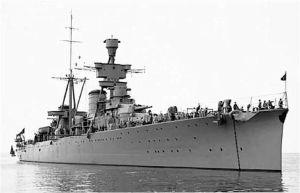 Alberico da Barbiano e Luigi Cadorna of the Ccondottieri Class.
Alberico da Barbiano e Luigi Cadorna of the Ccondottieri Class.
The Armando Diaz is in the foreground in the photo of which we thank our friend Giancarlo P. for providing us with this precious photo.
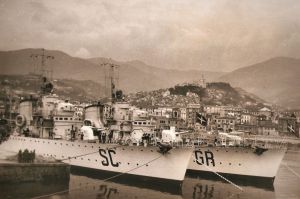
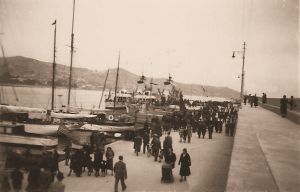 The team was completed by the Grecale, Grecale, Scirocco et Libeccio.
The team was completed by the Grecale, Grecale, Scirocco et Libeccio.
(the two photos of the fighters kindly provided by Adriano Amadio, sailor)
They formed the IV Naval Division and participated in a Naval Magazine in the presence of Mussolini and the German Defence Minister Von Blomberg.
(edited by Dino Tulaigo).
Year 1956
In 1956, in the picture below, concerning the Oberdan Gardens with the statue of the "Ondina" in the foreground, you can see a warship in the background.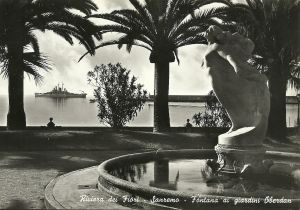 After careful research, we were able to identify the ship as the Heavy Cruiser Salem (CA 139) which, with the Des Moines, Newport News and Dallas (whose construction was later cancelled in 1946) were part of the US Navy's Des Moines Class.
After careful research, we were able to identify the ship as the Heavy Cruiser Salem (CA 139) which, with the Des Moines, Newport News and Dallas (whose construction was later cancelled in 1946) were part of the US Navy's Des Moines Class.
It was launched in 1947 and entered into service on 14 May 1949.
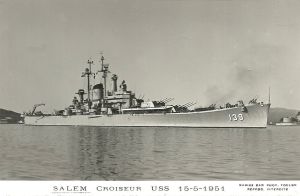 It was part of the Sixth Mediterranean Fleet as a flagship from May to September 1950 and then after 1951 to 1956 (when it was based in Villafranca on the Côte d'Azur for 20 months), then in 1957 and 1958 when, to celebrate the birth of Albert of Monaco (son of Prince Rainier and Grace Kelly) was visiting the Principality.
It was part of the Sixth Mediterranean Fleet as a flagship from May to September 1950 and then after 1951 to 1956 (when it was based in Villafranca on the Côte d'Azur for 20 months), then in 1957 and 1958 when, to celebrate the birth of Albert of Monaco (son of Prince Rainier and Grace Kelly) was visiting the Principality.
Retired from service on 30th January 1959 from October 1994 he was in Quincy, Massachusetts as a Museum Ship, part of the United States Naval Museum.
(Ship characteristics: Standard displacement 17,000 tons, full load displacement 21,500 tons. speed 33 knots, crew 1799; Armament 9 203 mm. guns, 12 127 mm. guns, 23 76 mm. guns, 12 20 mm. machine guns; It was disarmed in 1959 and was the last Heavy Cruiser in the world to enter service and the only one still existing as a Museum Ship).
Between November 1955 and August 1956, the US Navy aircraft carrier Ticonderoga (CVA 14) visited San Remo.
![]()
It was of the Essex Class, had a displacement of 40,000 tons and embarked 91 aircraft.
At the time of the visit she was part of the US Sixth Mediterranean Fleet based in Naples.![]() She had entered service in 1944 and participated in some naval operations of World War II. Modernised in 1950, she participated in the Vietnam War.
She had entered service in 1944 and participated in some naval operations of World War II. Modernised in 1950, she participated in the Vietnam War.
She was decommissioned in 1973 and sold for scrapping in 1975.
Her initial designation was CV 14 but after modernisation she became CVA 14 (attack aircraft carrier) and later CVS 14, that is an aircraft carrier with Anti-Submarine duties.
![]() This ship is named after the eponymous Fort Ticonderoga (1755 - 1759), built on a star-shaped plan in the 18th century in the southern part of Lake Champlain in New York State.
This ship is named after the eponymous Fort Ticonderoga (1755 - 1759), built on a star-shaped plan in the 18th century in the southern part of Lake Champlain in New York State.
It became famous in the history of the United States for the battles fought there in 1759, 1775 and 1777 between British and French troops, then a commando of US colonists and British soldiers, and finally US and British troops.
Personal testimony of Gian Franco Bianchi (member of our FB Group):
« The aircraft carrier remained in the roadstead together with other military units of various nationalities for a few days, to participate in a NATO manoeuvre that was taking place off the coast, from land you could hear the cannon blasts in the distance. She was equipped with the first embarked jet planes, the hissing of the reactors could be heard during the launch trials.
Fun fact: While the ship was at anchor, a group of ten- to eleven-year-old children accompanied by the Jesuit Fathers of St Stephen's were invited on board. Once visited the huge ship above and below deck, were taken to the mess hall and to our amazement were offered steaming hot chocolate in beautiful white ceramic cups. For all of us it was the first time we had tasted such a marvel and we repeatedly had seconds. Unforgettable! ».
(by Dino Taulaigo)
Year 1959
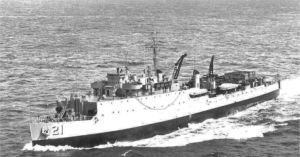 In April 1959, in April, the Landing Ship of the US Navy Fort Mandan (LSD 21) came to Sanremo.
In April 1959, in April, the Landing Ship of the US Navy Fort Mandan (LSD 21) came to Sanremo.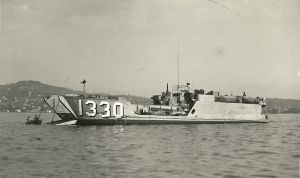 It bore the name of the Fort where in 1804/1805 the North American explorers Lewis and Clarck wintered and which was located in what would become North Dakota along the Missouri River.
It bore the name of the Fort where in 1804/1805 the North American explorers Lewis and Clarck wintered and which was located in what would become North Dakota along the Missouri River.
The ship participated in the Korean War and was part of the Sixth American Mediterranean Fleet from October 1952 to January 1953 and then from February to August 1959. (and it was in this second period that it visited Sanremo).
In 1971 it was sold to the Hellenic Navy where it took the name of Nafkratousa.
She embarked various types of landing craft: 5 LCT, 14 LCM of 1500 tons, 47 DUKW and 41 LVT. 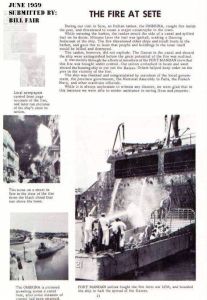 In July 1959, while he was visiting the French port of Séte, his sailors worked with the French fire brigade to put out the fire on the Italian tanker Ombrina. An event reported in this newspaper clipping.
In July 1959, while he was visiting the French port of Séte, his sailors worked with the French fire brigade to put out the fire on the Italian tanker Ombrina. An event reported in this newspaper clipping.
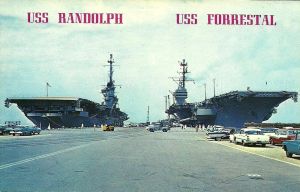 There are those who swear they saw the US Navy aircraft carrier Forrestal visiting the roadstead in Sanremo.
There are those who swear they saw the US Navy aircraft carrier Forrestal visiting the roadstead in Sanremo.
Someone had even seen her moored at the West Pier !!!!. Who swears to have seen the USS Randolph!!!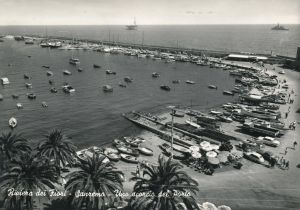 Well, I don't swear anything, they certainly didn't come either for me, let alone moored at the Western Pier (do you see an aircraft carrier of 81,000 tons entering the port?)
Well, I don't swear anything, they certainly didn't come either for me, let alone moored at the Western Pier (do you see an aircraft carrier of 81,000 tons entering the port?)
What I can say is that I remember the visit of the Saratoga, a Forrestal Class aircraft carrier of 81,000 tons, also fully loaded, which came to Sanremo before 1959, before I kept the Diario del Movimento Navi and the postcard confirms it.
(Personal note by Dino Taulaigo).
Also in 1959, in February, a team of 4 US Navy destroyers, the USS "Hank" (DD702), "English" (DD696), "Soley" (DD707) and the "John R. Pierce" (DD5753), dropped anchor in Sanremo.
(as the author noted in his diary "Navi Militari a Sanremo" when he was just 11 years old !!).
Year 1960
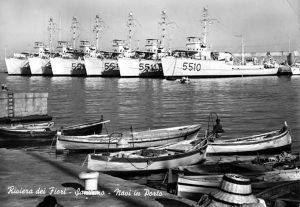 In August 1960 4 Minesweepers of the Italian Navy visited the port, 5510-Larice, 5511-Noce, 5512-Olmo, 5514-Pino, 5507-Faggio, 5516-Platano.
In August 1960 4 Minesweepers of the Italian Navy visited the port, 5510-Larice, 5511-Noce, 5512-Olmo, 5514-Pino, 5507-Faggio, 5516-Platano.
They were Mine Dredgers Wood and Fir Subclass. This subclass included 17 units built in US Shipyards to N.A.T.O. specifications between 1953 and 1957. They had the Monocarena hull in wood and therefore No-magnetic Materials.
(They were armed with two 20/70 mm. anti-aircraft machine guns in a twin system. Engine system: two Diesel engines with a power of 900 HP. Speed Max 14 knots.)
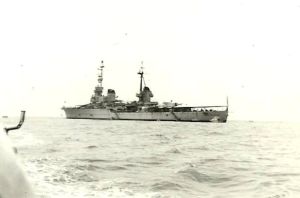
He was one of the 4 Cruisers of the Condottieri class (with the Cadorna, il Giuseppe Garibaldi,e il Duca degli Abruzzi) left to the Italian Navy by the Peace Treaty.
And when he came to Sanremo he had already been transformed into a School Ship.
He was disbarred 4 years later.
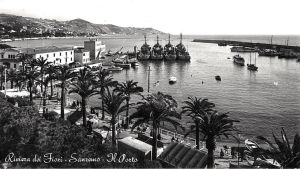 In August 1960 4 Agave Minesweepers of the Legni class, Agave subclass came to Sanremo to visit (but not when there was the Montecuccoli).
In August 1960 4 Agave Minesweepers of the Legni class, Agave subclass came to Sanremo to visit (but not when there was the Montecuccoli). 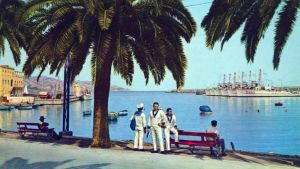 They were all built in Italian Shipyards. 5533-Edera and 5532-Alloro launched in 1955 at the CRDA of Monfalcone, 5538-Loto launched in 1956 at the Celli Shipyards of Venice, 5541-Trifoglio launched in 1955 at the Shipyards of Taranto.
They were all built in Italian Shipyards. 5533-Edera and 5532-Alloro launched in 1955 at the CRDA of Monfalcone, 5538-Loto launched in 1956 at the Celli Shipyards of Venice, 5541-Trifoglio launched in 1955 at the Shipyards of Taranto.
The Agave Subclass included 12 vessels.
(Displacement 405 tons s.l. , Propulsion 2 diesel engines 1200 HP, speed 14 knots -- armament 1 Bined machine gun 20/70 mm).
(sources: Dino Taulaigo text; images from personal archive)





